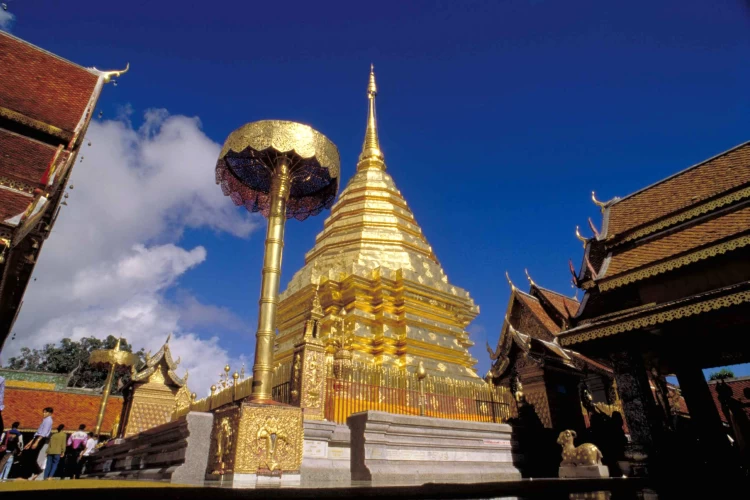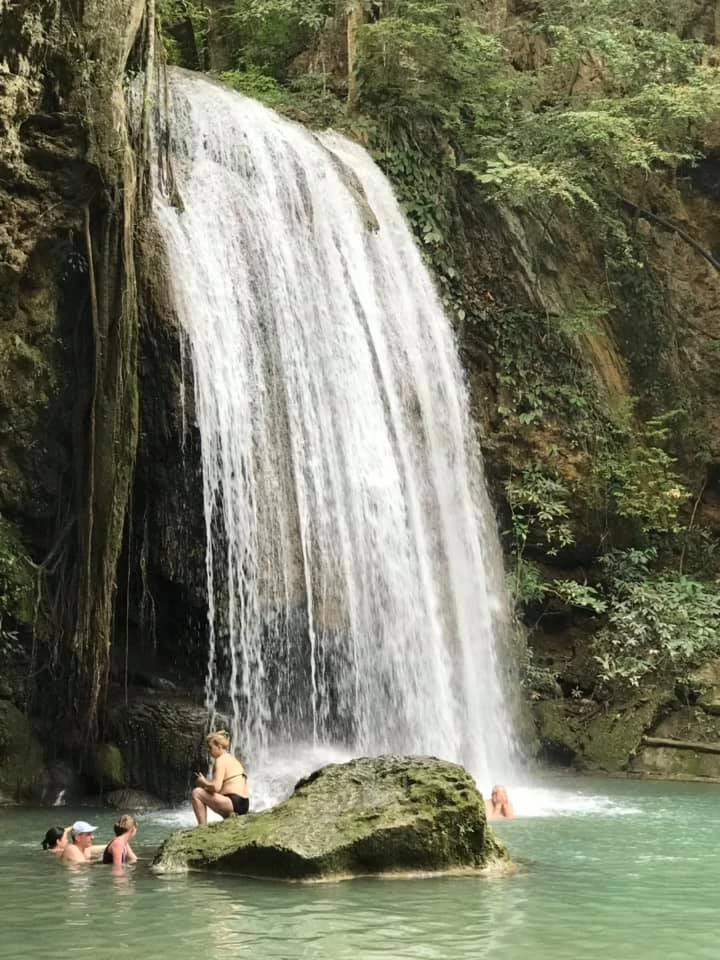
- Thailand|6 Days Tour

DAY 1: BANGKOK - KANCHANABURI, River Kwai: War Museum, Allied Cemetery, Train Riding, Muang Sing Historical Park. (L.)
DAY 2: KANCHANABURI - AYUTTHAYA: Sai Yok Yai National Park, Long Tail Boat (B.L.)
DAY 3: AYUTTHAYA - ANG THONG - KHAO YAI: Ayutthaya, Ang Thong, Khao Yai. (L.)
DAY 4: KHAO YAI - BANGKOK. Khao Yai National Park.
Day 1
BANGKOK - KANCHANABURI, River Kwai: War Museum, Allied Cemetery, Train Riding, Muang Sing Historical Park. (L.)
06:30 Meeting with the Guide and Departure for Kanchanaburi, with arrival expected around 09:30. Start of visits
Kanchanaburi is a city in western Thailand. It is known for the death railway, built during the Second World War. The line crosses the Khwae Yai river through the Death Railway Bridge. Exhibits at the JEATH War Museum honor the prisoners of war who died building the bridge. The Thailand-Burma Railway Center explores the wider history of the railway. Nearby, thousands of allied soldiers are buried in the Kanchanaburi war cemetery.
10:45 - Boarding the train for a scenic route, up to Tham Krasae. Stop for lunch, and time to visit the area with the Tham Krasae Bridge next to the cave of the same name. In this area the train slows down at a walking pace as it crosses the precarious looking bridge known as the Wang Pho viaduct. A wall of rock towers is a short distance to the right, with a drop overhanging the river and phenomenal views on the left, another highlight of the trip.
After lunch, visit the Prasat Muang Singh Historical Park, here we find traces of the Khmer Kingdom, once flourishing, in one of the best known religious structures in Thailand. Historians have estimated that Prasat Mueang Singh, and its surrounding architecture on the bank of the Kwai Noi River, were built between 857 and 1157 as a religious temple of the Khmer kingdom. Later, the temple was abandoned until the reign of King Rama I when the Mueang Singh area became one of the border towns of Kanchanaburi. The restoration of the structures, however, was not completed until 1987.
The main remaining structure is Prasat Mueang Sing itself (the Tower of the City of Lions), a Khmer-style architecture with influences from the arts of Lop Buri. It is framed by city walls of 800 x 1,500 meters. During the excavations, historians found valuable artifacts, antiques, ceramics and religious ornaments with over 2000 years of history.
At about 15:00 Transfer to the hotel. Check In. Rest of the evening available.
Day 2
KANCHANABURI - AYUTTHAYA: Sai Yok Yai National Park, Long Tail Boat (B.L.)
Visit on a private basis at about 08:30.
At 09:30 am Arrival at the pier and boarding on a long tail that accompanies you to the park, amidst beautiful scenery.
At around 10:30 am arrival at Sai Yok National Park and start of visits. The Park In addition to being a home for numerous wild animals, such as squirrels, bats, deer and birds, it is also the home of the smallest mammal in the world, the bat with the muzzle of the double-headed kitten, first discovered in 1973. lunch is served in local restaurant or packed
At 14:00 Ca, departure for Ayutthaya with arrival at the hotel approx. 17.30-18.00
Day 3
DAY 3: AYUTTHAYA – ANG THONG – KHAO YAI ( Bang Pa-In • Ayutthaya Historical Park • Wat Muang • Wat Sang Kratai approx. 260 km (L.)
08:00 – Departure from hotel
Meet your guide at the hotel lobby and start the journey to explore the ancient capital of the Siam Kingdom.
Start with Ayutthaya Historical Park and Visit the most significant temples:
Wat Mahathat – famous for the Buddha’s head entwined in tree roots.
Wat Phra Sri Sanphet – the most important temple of Ayutthaya, featuring three majestic chedis.
Wat Lokayasutharam – home to an impressive 42-meter reclining Buddha.
Wat Chaiwatthanaram – a beautiful Khmer-style riverside temple with panoramic views.
12:30 – Lunch at a local restaurant.
Afternoon – Ang Thong
Wat Muang – known for its 95-meter-high golden seated Buddha, the tallest in Thailand.
Wat Sang Kratai – an ancient temple intertwined with Bodhi tree roots.
17:30–18:30 – Arrival in Khao Yai and hotel check-in.
Evening at leisure.
Day 4
DAY 4: KHAO YAI - BANGKOK. Khao Yai National Park.
Meeting with the Guide at about 08:00.
08:30 KHAO YAI NATIONAL PARK
Khao Yai is arguably the best national park in Thailand where it is relatively easy to see the number of interesting animals.
Founded in 1962 as Thailand's first national park, it is the third largest national park in the country. Located mainly in the Nakhon Ratchasima province, Khao Yai extends into the provinces of Prachinburi, Saraburi and Nakhon Nayok. The Khao Yai checkpoint is only 2.5 hours from Bangkok.
The park covers an area of 2,168 square kilometers, including rainforests / evergreens and grasslands. With 1,351 m high Khao Rom is the highest mountain in the park. The average altitude of the national park varies from 400 to 1000 m above sea level.
Khao Yai is part of the Dong Phayayen-Khao Yai forest complex, declared a World Heritage Site by UNESCO, which covers 5 areas protected by Khao Yai on the Cambodian border. The other protected areas are; Pang Sida National Park, Thap Lan National Park, Ta Phraya National Park and Dong Yai Nature Reserve.
nature
Some mammals that can be seen include elephants, macaques, deer, gibbon, porcupine, civet. Other relatively common, but not easy to meet mammals are bears, gaur, otters, dhole, jackals, for some time there have been no signs of tiger activity in the park, but photo traps have revealed a significant population of tigers in nearby Thap Lan and Pang Sida National Park. There is only one Siamese crocodile in the national park and it can be seen in the same position along one of the trails. According to guides operating in the park, the crocodile has been released by park staff in the past.
The national park is home to around 300 residents and migratory birds and has one of the largest hornbill populations in Thailand. Many land birds such as silver pheasants, wild jungle, green-legged partridges and Siamese water fires are common on roads and paths. The best time to visit Khao Yai for bird watching is during the dry months and during March April when bird migration occurs.
Khao Yai is also a good destination for reptile watching. The best time is around March-April, but with good activity until October, during the cold seasons it takes a little more effort to locate them. Reticulated python, Ahaetulla prasina, Chinese ratsnake, Chinese water dragon, Water Lizard and crested lizards are just some of the many species that can be found in the park.
Lunch is served in a local restaurant between 12:30 and 13:30.
The arrival in Bangkok is expected around 18: 00-18: 30. In case of transfer to the airport, plan to fly after 20:30.
INCLUDED:
- Local Licensed Guide
- Transportation by air-conditioned vehicle
- Entrance tickets
- 4 lunches in a local restaurant
- Boats as per program
- 3 nights with breakfast
EXCLUDING:
- Personal expenses
- Anything not mentioned in the program
- Tips
Unlimited Seats
DAY 1 CHIANG MAI ARRIVAL TRANSFER.
DAY 2 CHIANG MAI Trekking, The Monks' Trail, Wat Palad & Wat Pratat Doi Suthep. (B.L.)
DAY 3 CHIANG MAI LAMPUN LAMPANG Wat Haripunchai, Elephant Hospital, Tung Kwaing Market. (B.L.)
DAY 4 LAMPANG PHAYAO CHIANG RAI. Wat Chaloem Prakiet, Phayao Lake, (B.L.)
DAY 5 CHIANG RAI Golden Triangle, Opium Museum, Doi Tung, Mae Fah Luang Garden. (B.L.)
DAY 6 - CHIANG RAI. TRANSFER. (B.)
View MoreUnlimited Seats
DAY 1 CHIANG MAI ARRIVAL TRANSFER.
DAY 2 CHIANG MAI Trekking, The Monks' Trail, Wat Palad & Wat Pratat Doi Suthep. (B.L.)
DAY 3 CHIANG MAI LAMPUN LAMPANG Wat Haripunchai, Elephant Hospital, Tung Kwaing Market. (B.L.)
DAY 4 LAMPANG PHAYAO CHIANG RAI. Wat Chaloem Prakiet, Phayao Lake, (B.L.)
DAY 5 CHIANG RAI Golden Triangle, Opium Museum, Doi Tung, Mae Fah Luang Garden. (B.L.)
DAY 6 - CHIANG RAI. TRANSFER. (B.)
View MoreUnlimited Seats
DAY 1 CHIANG MAI ARRIVAL DOI SUTHEP, CITY TEMPLES, MONKS' CHANTING. (L.)
DAY 2: CHIANG MAI ELEPHANT SANCTUARY. GROUP DAY IN ENGLISH (Transfers and Guide Provided by the Sanctuary) (B.L.)
DAY 3 - CHIANG MAI CHIANG RAI Mae Krachan, White Temple, Golden Triangle, Wat Phra That Pu Khao, Opium Museum, Ethnic Minority. (B.L.)
DAY 4 - CHIANG RAI. TRANSFER. (B.)
View More